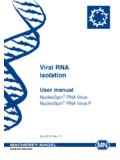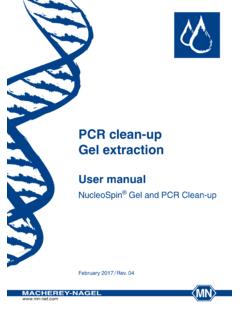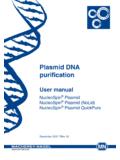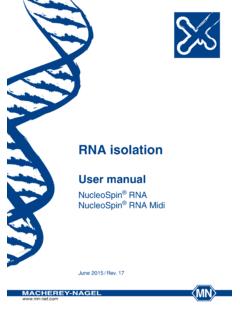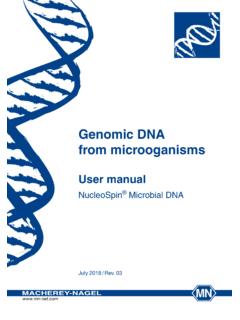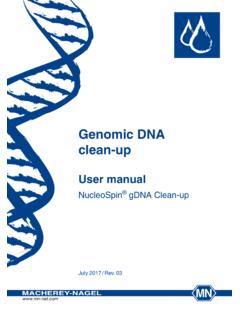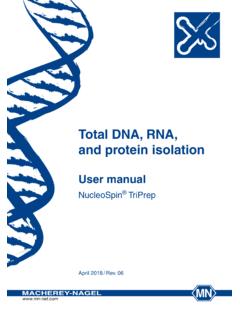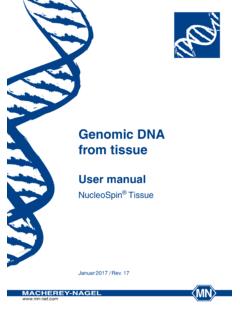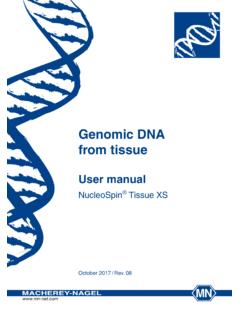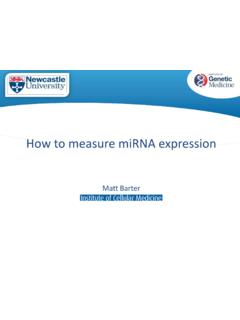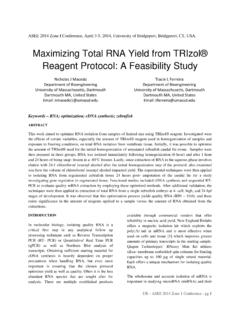Transcription of Small RNA and DNA from Plasma - Macherey …
1 Small RNA and DNA. from Plasma User manual NucleoSpin miRNA Plasma December 2017 / Rev. 05. Isolation of miRNA from Plasma Protocol-at-a-glance (Rev. 05). NucleoSpin miRNA Plasma 300 L Plasma or serum*. 90 L MLP. 1 Prepare sample Vortex 5 s RT, 3 min 30 L MPP. Vortex 5 s 2 Precipitate protein RT, 1 min 11,000 x g, 3 min Transfer clear supernatant to 3 Transfer supernatant Collection Tube (2 mL, lid). 4 Adjust binding 400 L isopropanol conditions Vortex 5 s Load sample on NucleoSpin . miRNA Column 5 Bind RNA and DNA. RT, 2 min 11,000 x g, 30 s Optional: 700 L MW2. 1st 11,000 x g, 30 s 6 Optional: 250 L MW2. 2nd 11,000 x g, 2 min Digest DNA. 50 L rDNase in Reaction Buffer for rDNase RT, 15 min 100 L MW1. 1st 11,000 x g, 30 s 700 L MW2. 7 Wash and dry 2nd 11,000 x g, 30 s 250 L MW2. 3rd 11,000 x g, 2 min 30 L RNase-free H2O. 8 Elute RNA RT, 1 min 11,000 x g, 1 min * Larger sample volumes can be processed when buffer volumes of MLP, MPP, and isopropanol are increased proportionally.
2 Multiple loading is necessary in step 5 (see section for more information). Macherey -NAGEL GmbH & Co. KG Neumann-Neander-Str. 6 8 52355 D ren Germany Tel.: +49 24 21 969-270 Fax: +49 24 21 969-199 Small RNA and DNA from Plasma Table of contents 1 Components 4. Kit contents 4. Reagents, consumables, and equipment to be supplied by user 5. About this user manual 5. 2 Product description 6. The basic principle 6. Kit specifications 6. Amount of starting material 6. Proteinase K digest 8. Addition of carrier 8. Elution procedures 8. 3 Storage conditions and preparation of working solutions 9. 4 Safety instructions 10. 5 Protocol - Small RNA and DNA purification from Plasma or serum 12. 6 Appendix 15. Product use restriction / warranty 16. Troubleshooting 15. Ordering information 16. Product use restriction / warranty 16. Macherey -NAGEL 12/2017, Rev. 05 3. Small RNA and DNA from Plasma 1 Components Kit contents NucleoSpin miRNA Plasma 10 preps 50 preps 250 preps REF Lysis Buffer MLP 3 mL 13 mL 75 mL.
3 Protein Precipitation Buffer MPP 5 mL 5 mL 25 mL. Reaction Buffer for rDNase 7 mL 7 mL 30 mL. rDNase, RNase-free (lyophilized) 1 vial 1 vial 5 vials (size C) (size C) (size C). Wash Buffer MW1 10 mL 10 mL 35 mL. Wash Buffer MW2 (Concentrate)* 6 mL 25 mL 100 mL. RNase-free H2O 13 mL 13 mL 13 mL.. NucleoSpin miRNA Columns 10 50 250. (green rings). Collection Tubes ( mL) 10 50 250. Collection Tubes (2 mL) 10 50 250. Collection Tubes (2 mL, lid) 10 50 250. User manual 1 1 1. * For preparation of working solutions and storage conditions see section 3. 4 Macherey -NAGEL 12/2017, Rev. 05. Small RNA and DNA from Plasma Reagents, consumables, and equipment to be supplied by user Reagents 96 100 % ethanol Isopropanol Consumables RNase-free disposable pipette tips Equipment Manual pipettors Vortexer Centrifuge for microcentrifuge tubes Personal protection equipment (lab coat, gloves, goggles). About this user manual It is strongly recommended that first-time users of the NucleoSpin miRNA Plasma kit read the detailed protocol section of this user manual.
4 Experienced users, however, may refer to the Protocol at a glance instead. The Protocol at a glance is designed to be used only as a supplemental tool for quick referencing while performing the purification procedure. All technical literature is available on the internet at Macherey -NAGEL 12/2017, Rev. 05 5. Small RNA and DNA from Plasma 2 Product description The basic principle The NucleoSpin miRNA Plasma kit offers the unique feature to isolate total RNA including Small RNA and DNA from serum and Plasma without the need to resort to the cumbersome phenol / chloroform extraction or a time consuming proteinase digest. The sample material is denatured in Lysis Buffer MLP. The protein is then precipitated by Protein Precipitation Buffer MPP and pelleted by centrifugation. After the removal of protein the binding conditions for nucleic acids are adjusted by adding isopropanol. Total nucleic acids are bound to the NucleoSpin miRNA Column.
5 Optionally, DNA can be removed by an on-column rDNase digest. The remaining nucleic acids are washed and eluted with minimal amounts of RNase-free water. Kit specifications The NucleoSpin miRNA Plasma kit is designed for the isolation of RNA and DNA. from cell free blood Plasma or serum. rDNase is provided for an optional on-column digest to remove traces of genomic DNA. The eluted RNA and DNA are ready to use for all standard downstream applications, for example, qPCR, qRT-PCR, Northern Blot, chip hybridization. Table 1: Kit specifications at a glance Parameter NucleoSpin miRNA Plasma Sample size 300 L blood Plasma or serum Binding capacity 200 g Elution volume 20 50 L. Preparation time 40 min/10 preps (without rDNase digest). 70 min/10 preps (with rDNase digest). Amount of starting material The standard procedure allows to process 300 L of sample material with only one loading step onto the NucleoSpin miRNA Column.
6 This is usually enough to detect also low abundance miRNA in Plasma or serum. If larger sample volumes are to be used to increase the sensitivity even further, the volumes of Buffer MLP and Buffer MPP as well as the isopropanol have to be increased proportionally. Multiple loading steps per sample are necessary. But, consider that doubling or tripling the starting volume will result in an only 1 cycles earlier signal in qRT-PCR, which is rather insignificant for detection sensitivity compared to the much larger differences that occur from sample to sample or between different miRNAs. 6 Macherey -NAGEL 12/2017, Rev. 05. Small RNA and DNA from Plasma Furthermore, if Plasma quality is low, co-purified RT-PCR inhibitors might require diluting the eluate and thereby counteract the increased yields. Figure 1 shows qRT-PCR results from eight different Plasma samples analyzed for miR-16. (very high expression) and miR-1 (very low expression).
7 They differ in average by about 14. cycles, which is a difference in expression by 3 4 orders of magnitude ( fold)! Doubling the amount of sample material would just shift the mean values from to (miR-1) and from to (miR-16). This is much less than the variation from sample to sample and can thus be neglected. Figure 1 qRT-PCR quantification of miR-1 and miR-16. MiRNA from only 300 L of eight different blood Plasma samples were purified and eluted in 30 L RNase-free water. 2 L of each eluate were used for a 10 L RT reaction (Applied Biosystems, TaqMan MicroRNA RT Kit) with miRNA. specific primers (Applied Biosystems, hsa-miR-1 MicroRNA Assay and hsa- miR-16 MicroRNA Assay). The RT reaction mix was diluted 1:10. Only 4 L of the resulting 100 L were used for the PCR reaction (Applied Biosystems TaqMan . Universal PCR Master Mix) in combination with the MicroRNA Assays for specific priming mentioned before. Preparation of Plasma from human EDTA blood 1 Centrifuge fresh blood sample for 10 min at 2,000 x g.
8 2 Remove the Plasma without disturbing sedimented cells. 3 Freeze Plasma at -20 C for storage upon DNA isolation. 4 Thaw frozen Plasma samples prior to DNA isolation and centrifuge for 3 min at 11,000 x g in order to remove residual cells, cell debris, and particulate matter. Use the supernatant for DNA isolation. Macherey -NAGEL 12/2017, Rev. 05 7. Small RNA and DNA from Plasma Proteinase K digest A short protein digestion step might increase miRNA yield, especially for low quality, hemolyzed Plasma . Add 10 L of Proteinase K (~ 30 g/ L in Buffer PB, see ordering information) to 300 L Plasma , incubate for 10 min at 37 C, and then proceed with addition of Buffer MLP according to the protocol. Addition of carrier To improve RNA / DNA binding to the NucleoSpin miRNA Column, carrier can be added to the sample after the removal of precipitated protein. Slightly higher yields could be found with 2 g of glycogen or 5 g of LPA (linear polyacrylamide).
9 However, negligible effects were observed for Poly-A which furthermore interferes with a photometric quantification of the purified nucleic acids. Elution procedures The elution buffer volume does not only influence total yield and concentration of RNA and DNA, but does also influence the ratio between very Small and larger oligonucleotides: 20 L. The silica membrane is not completely wetted. Only weakly binding very Small oligonucleotides like miRNA are eluted efficiently. Larger RNA and DNA are more likely to remain bound to the column. The eluted miRNA is highly concentrated. 30 L (standard). The standard elution buffer volume of 30 L is sufficient to wet the silica membrane completely. It results a high total yield of miRNA / RNA / DNA and simultaneously maximizes the concentration. 50 L. Increasing the elution buffer volume will further increase the final yield but consequently will reduce the concentration.
10 The gain in yield will usually not compensate for the loss in sensitivity of miRNA detection caused by the dilution of the eluate. Furthermore, larger RNA. and DNA will be eluted more efficiently, which might, however, be interesting for the analysis of circulating DNA. 8 Macherey -NAGEL 12/2017, Rev. 05. Small RNA and DNA from Plasma 3 Storage conditions and preparation of working solutions Attention: Buffers MLP and MW1 contain guanidinium thiocyanate. Wear gloves and goggles! Storage conditions: Store lyophilized RNase-free rDNAse at +4 C on arrival (stable for at least one year). All other kit components should be stored at room temperature (18 25 C) and are stable for at least one year. Storage at lower temperatures may cause precipitation of salts. Before starting the first NucleoSpin miRNA Plasma procedure prepare the following: Wash Buffer MW2: Add the indicated volumes of 96 100 % ethanol to the MW2. concentrate.
